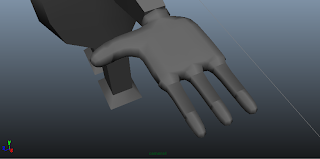This is the first full detailed human body rigging i have ever done and WOW! I have got to say i have this new found respect for riggers! It was a lot hard work and patience! What i have experienced here is that rigging steps does not always go the way you would imagine it'll go. Like getting the local rotational axis to all go in the same direction.
This was the part, i felt myself (i know its a little dramatic but its 19 video tutorials) dying a little inside each time it did not work no matter in which direction i orientated the axis to go( believe me i tried every single combination). The right hand was the one giving me so much problems because it did not cooperate and jerked out of the model each time i did anything at all to the joints (even parenting). I can't count how many times i re-arranged it.
Anyway, back to the local rotational axis, you may think like, "hey its okay if it doesn't work. The guy in the tutorial said that it was your choice to do it or not anyway." But NO! I need to point out here how much work you're saving yourself later if you get the axis right at first because when you get to the "set Driven Key Stage" and pair up the "rotate" function from driver to driven, you only have to rotate one direction (X, Y or Z) but if you notice in my screenshot below, my axis are pointed down diagonally and i couldn't just rotate it in one direction because it'll not appear human at all. I had to rotate function in 2 or even 3 directions to get the correct 90 degrees movement. Like this,
Also, for the thumb its a bit tricky because it wasn't included in the video tutorial and you have to consider how the thumb should go like instead of up and down, it faces the side. So you can't blindly do the same thing for each finger.
Here's the full body screenshot of my rig,
Here's the full body screenshot of my rig,
Side view (better spine to head controller view),
the legs (better foot to knees controller view),
the hand (better hand controller view),
At one point before the smooth skin binding we had to do another step first which was to create an IK Spline Handle to give some "stretchiness" to the spine. The interesting part here was the MEL Command. Its my first time knowing what it does. Its basically for codes to create a boolean to return arclength of a curve. The code is : arclen -ch on BindSpineSIKCurve; (we named our curve BindSpineSIKCurve before that) and this step is to add stretch to the chain which i have learnt from pages from this book,
Unfortunately, i can't paste the book details here because that would be copyrighting but its a good book to help you understand more about the MEL Command and rigging. So check out this book if you want to learn more.
Extra details
-ch stands for construction history http://autodesk.com/us/maya/2011help/Commands/arclen.html
Extra details
-ch stands for construction history http://autodesk.com/us/maya/2011help/Commands/arclen.html
Next is the linking of to the multiplydivide node. One silly mistake i made, was spending so much time trying to find the "input1.inputX" because i was trying to link the arclength of the curveinfo to it. And arclength appeared when i right-clicked the curveinfo node but only output appeared for mulitplydivide. Finally, through experimenting, it actually appears naturally when you hover your link thread from the arc length over it. Its embarrassing really! Hope you guys don't make the same mistake! Here's a webpage for you to better understand the inputs and outputs of the multiplydivide node. file:///C:/Program%20Files/Autodesk/Maya2011/docs/Maya2011/en_US/Nodes/multiplyDivide.html
Rigging has a lot of steps so start from the first step which is the pelvis because its the center and make your way up:) Good Luck!



























